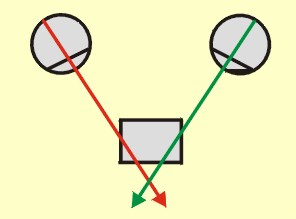
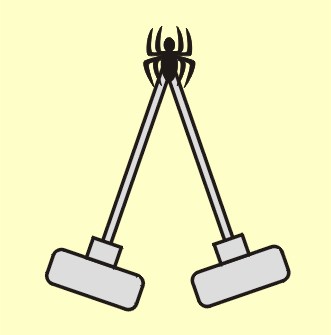
Fig. 1 Stereoscopic viewing
STEREO IMAGES GENERATED FROM ONE SINGLE MICRO PHOTOGRAPHY ONLY
1. Stereoscopics
Figure 1 demonstrates how 3D-impressions are generated: We look at objects with different viewing angles, so our eyes produce slightly different images sent to our visual cortex. The visual cortex is able to merge these two different images to one coherent image generating the 3D-impression simultanously by analysing the small differences. If you take two photos of an object with different viewing angles (Fig.2) presentig each of them to one eye only, then afterwards you will see a threedimensional image.
 |
 |
|
Fig. 1 Stereoscopic viewing |
Fig.2 Stereophotography |
2. How to use stereo images
Figure 3 shows a stereo-pair taken with a scanning electron microscope (SEM). To get these images the object has been tilted by 5 degrees in both directions. The left image is assigned to the left eye, the right one to the right eye. To get a 3D-impression sit relaxed in front of the screen at a distance of about 80 cm and see "dreamingly" through the screen. The axes of your eyes will become parallel now and you will see two more images which more or less overlap. Suddenly with a"click" these two images merge and form a 3D-image hovering in front of the screen. Having been successful once this method will work everytime because in this particular case our brain learns very quickly what is demanded. But there is one restriction: The distance of the centers of the two images must be equal to the distance of our eyes (about 8 cm), so this method is unsuitable for larger images.
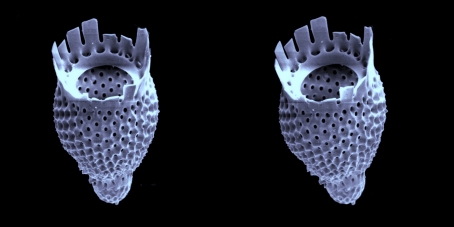 |
|
Abb.3 Pair of stereo images to be looked at with parallel eye axes |
Figure 4 shows a similar stereo-pair, but now the image assigned to the right eye is positioned left and vice versa. Again sit relaxed in front of the screen, but now try to squint willingly. You will see two more overlapping images and as described above with a "click" the two images will merge to a 3D-image. From that moment our brain keeps the axes of our eyes stable, so you must not squint willingly any more and you can look at the 3D-image without any further stress. This method is not restricted to small images, it even works with large images projected with a beamer.
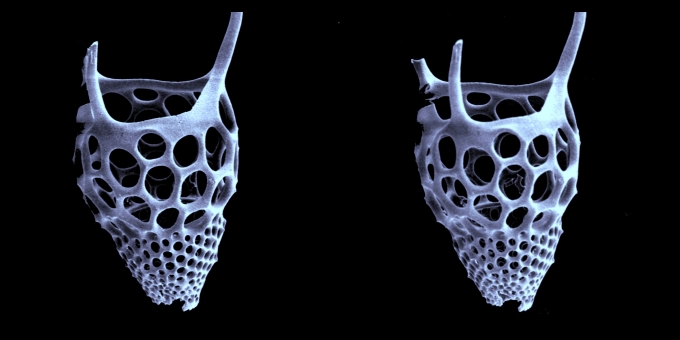 |
|
Fig. 4 Pair of stereo images to be looked at with eye axes crossed |
At least there is the option to merge the two stereo images to get an anaglyph looked at with anaglyph goggles (red filter assigned to the left eye). But whereas the methods given above even work with colour images, in this case the stereo images must be converted to gray scale images first, then they are stained red and bluegreen (=cyan) respectively and merged. Many image processing programs have a special routine which stains and merges the images in one step. It is noteworthy that the amount of shift between the two images has no effect on the shape of the object, it only defines how far the object will hover in front or behind the screen (Fig.5). Viewing the anaglyph makes no problems, but by merging the two images a certain loss of quality is unavoidable, especially in case of delicate textures in the midth of the anaglyph. So the methods given above are preferable.
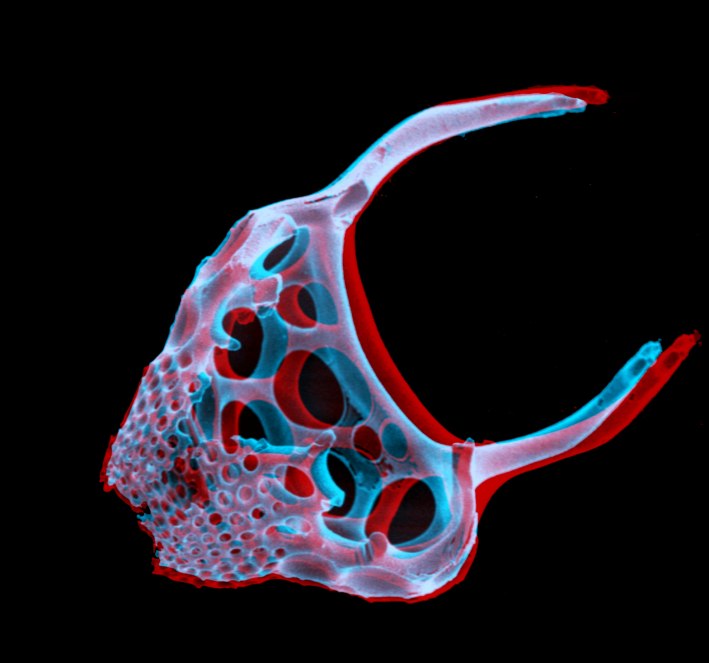 |
|
Fig.5 Anaglyph |
3. Stereo images based on one single image only
From the scientific point of
view the bumblebee can not fly at all;
the ignorant animal does not
know that and flies nonetheless.
The explanation given above clearly demonstrates that stereo images are pairs of different images taken with different viewing angles. In consequence of that both images differ in information. So, if you distort a single image in different ways to get a pair of stereo images both images will contain the same information, as nothing has been added or removed. How can this lead to a 3D-impression then? The explanation will be given later, first the method itself will be demonstrated.
To apply the method successfully you need images of objects with distinct edges and textures and of wide depth of field. In addition the background must be neutral (empty). Typical examples are SEM-images or stacked images of micro-organisms. For more details see the page dealing with the stacking program PICOLAY.
Figure 6 gives the single image the pair of stereo images are generated with, figure 7a and 7b shows the stereo images distorted vertically in a trapezoidal way. Figures 8, 9 and 10 show the resulting stereo images.
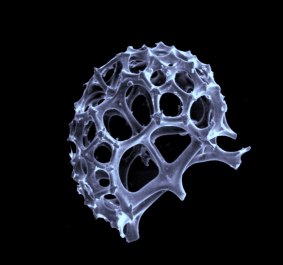 |
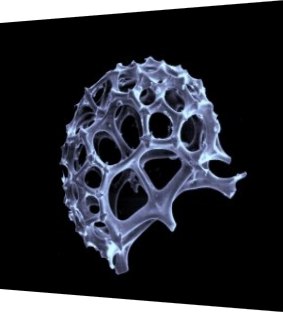 |
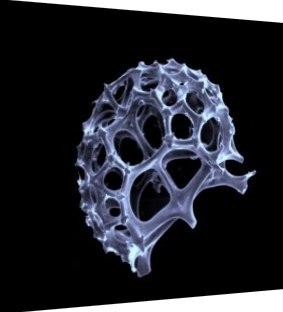 |
|
Fig.6 Single photo |
Fig.7a
Stereo image assigned to the right eye |
Fig.7b Stereo image assigned to the left eye |
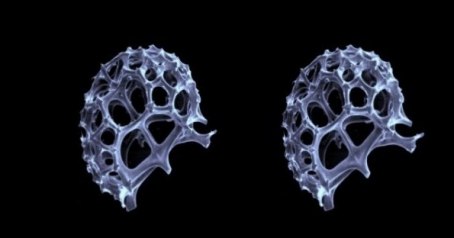 |
|
Fig.8 Left-right-pair to be looked at with parallel eye axes |
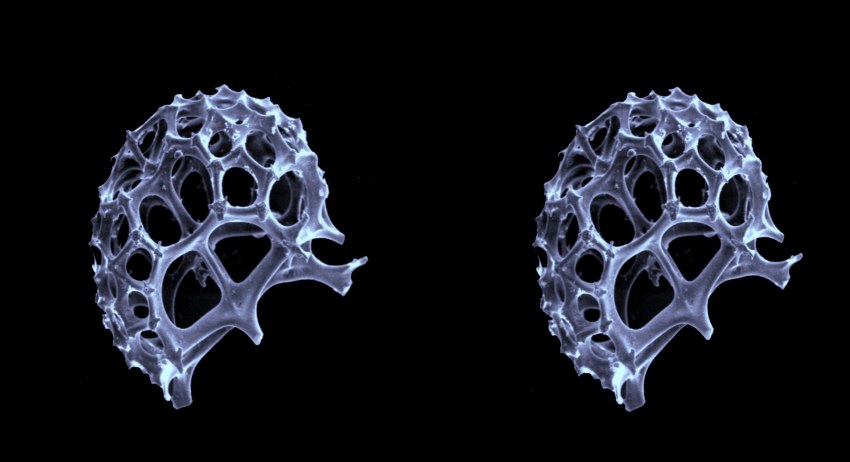 |
|
Fig.9 Rgiht-left-pair to be looked at with eye axes crossed |
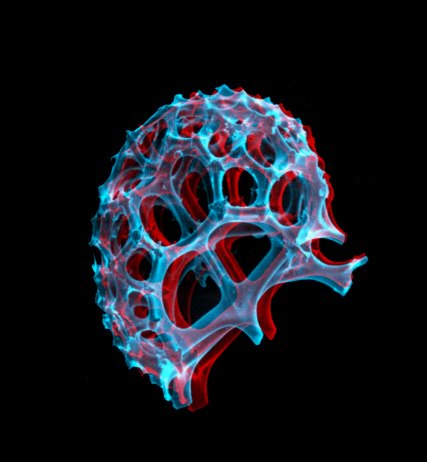 |
|
Fig.10 Anaglyph |
Generating stereo impressions is a highly complex procedure performed of our visual cortex which analyses many quite different informations simultanously. Because of the importance of the ability to estimate distances the image processing ability of the visual cortex is of high redundancy. So persons who are blind on one eye are not only able but even allowed to drive a car. In that case the visual cortex evaluates the relative size of known objects and the different movement of objects of the foreground in relation to the background if one moves. Our visual cortex is, so to speak, even "content" with incomplete informations.
When looking at an object with both eyes that part of the object pointing to the right eye produces a larger part of the whole image in the right eye than in the left and vice versa, and it is just this the method described here makes use of (see Fig.7a and 7b). Although some information is lacking - in this case we do not look a little bit "around" the object (see Fig.1) - the incomplete information is sufficient to enable our visual cortex to generate a correct 3D-impression.
To demonstrate the effiency of this method a small set of anaglyphs is given below. Click on the thumbs.
Copyright: webmaster@mikrohamburg.de